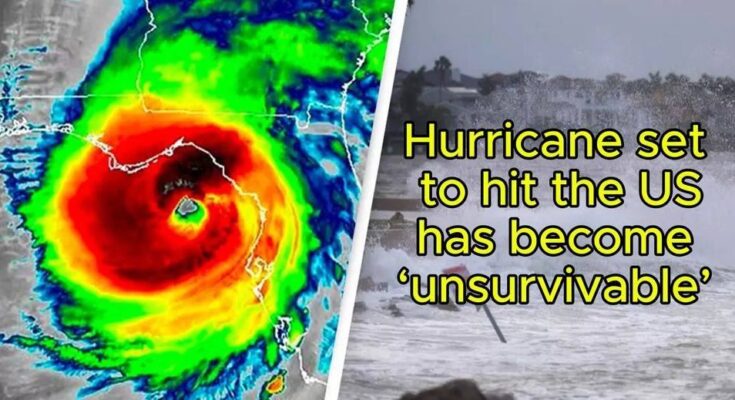Hurricane Rafael, an unusual November storm, is gathering strength and moving toward the United States with significant force, having recently been upgraded to a Category 2. With maximum sustained winds currently reaching 110 mph, Rafael represents a rare and potentially severe threat for this time of year, particularly for regions from Texas to the Florida Panhandle. Forecasts indicate that western Cuba will be among the first to feel the storm’s impact, with landfall expected within hours, according to the latest data from the National Hurricane Center (NHC). This puts communities in Cuba, as well as in the southeastern US, on high alert.
The NHC has issued hurricane warnings for areas along the projected path, including the Florida Keys, where up to three inches of rainfall and an increased tornado risk are anticipated. Flash flooding in low-lying areas remains a concern, especially as Rafael could continue to gather strength before moving over the Gulf of Mexico. “People in the Florida Keys and Gulf Coast regions should be prepared for significant weather disruptions,” NHC officials have warned, urging residents to monitor the latest advisories closely.
As Rafael moves across warm Caribbean waters, it could undergo what meteorologists call “rapid intensification”—a phenomenon where storm winds increase dramatically within a short time, especially when ocean temperatures are high. The Gulf’s waters remain warmer than average this year, adding energy that could fuel further storm development. Rafael is currently on track to be the strongest November hurricane in the northwestern Caribbean since 2009. Meteorologists are closely watching the storm’s progression for any indications that it might increase in strength before making landfall.
Unlike the usual hurricane season, which tends to see most storms develop between June and October, hurricanes in November are less common. Rafael’s formation so late in the year is a testament to the ongoing changes in climate and ocean patterns, experts suggest, as warmer waters extend hurricane season timelines. These patterns are influenced by a range of factors, from seasonal weather shifts to warming ocean temperatures. Such conditions create an environment that allows for unexpected and intense storms well beyond the typical end of hurricane season.
Local authorities in the Florida Keys and along the Gulf Coast have begun preparing for potential impacts by securing infrastructure, setting up emergency shelters, and organizing resources for potential evacuations if Rafael’s trajectory suggests a more direct threat to populated areas. Schools and businesses in some counties are making contingency plans, and Florida’s Department of Emergency Management has begun coordinating with local agencies to ensure readiness. Residents, especially those in flood-prone areas, are advised to gather emergency supplies, fuel vehicles, and secure their homes in preparation for possible evacuations.
As Floridians brace for Rafael, many are still recovering from previous storms this year, making the added threat of another hurricane particularly stressful for residents and emergency responders alike. The state’s infrastructure and public services are still under strain from earlier storms, which caused damage to power lines, flooded streets, and even necessitated temporary relocations for many residents. For some, Rafael’s approach brings back memories of past November hurricanes, like Hurricane Ida in 2009, which wreaked havoc on parts of the Gulf Coast.
The storm’s potential impacts go beyond heavy rainfall and high winds. Tornado activity, which often accompanies hurricanes as they move inland, could create additional challenges for affected areas. The NHC has emphasized that even residents far from the center of Rafael’s path could experience dangerous conditions, particularly from severe thunderstorms and high winds. Coastal flooding and power outages are also anticipated in several counties, prompting local governments to issue safety advisories. Utility companies in the region are coordinating response teams to manage potential outages and to restore power as quickly as possible should disruptions occur.
Meteorologists note that forecasting models currently show Rafael weakening slightly once it enters the Gulf of Mexico, but they caution that this is by no means guaranteed. The combination of warm Gulf waters and atmospheric conditions could allow Rafael to maintain its strength longer than initially anticipated. This uncertainty highlights the importance of staying informed as new data becomes available. As such, emergency alerts and advisories are expected to be updated frequently, especially as Rafael’s exact path and strength become clearer over the next 24-48 hours.
In anticipation of heavy rains, Florida’s water management authorities have been assessing canals, levees, and flood controls, especially in regions where previous hurricanes have weakened protective structures. This preventive work is intended to help manage the expected surge in water levels, which could reach hazardous levels if Rafael intensifies further. In the Florida Keys, which lie directly within Rafael’s path, residents are encouraged to take precautions, including relocating boats and securing outdoor furniture that could become dangerous debris in strong winds.
Meanwhile, local volunteer organizations and emergency response teams are mobilizing to provide additional support to communities likely to be impacted by the storm. The Red Cross and other disaster relief groups have been coordinating resources and stand ready to assist with evacuation support, temporary sheltering, and essential supplies. Past hurricanes have shown that preparedness and swift response are crucial in minimizing both the immediate and long-term effects of severe storms, particularly in areas vulnerable to flooding and infrastructure damage.
Residents are urged to take warnings seriously and avoid complacency. Many have already taken to social media to share safety tips, emergency numbers, and weather updates, creating a collective network of support and information. This collaborative approach, often seen in disaster-prone areas, can be lifesaving, especially as residents make critical decisions regarding evacuation and sheltering.
As Rafael inches closer, the NHC and other weather agencies will continue to monitor its movement and issue regular updates. Floridians and those along the Gulf Coast are strongly encouraged to keep an eye on local news sources, government advisories, and weather alerts to stay prepared for any changes in Rafael’s path or intensity. With the potential for rapidly shifting conditions, readiness remains key to weathering what could be an intense and challenging storm.



